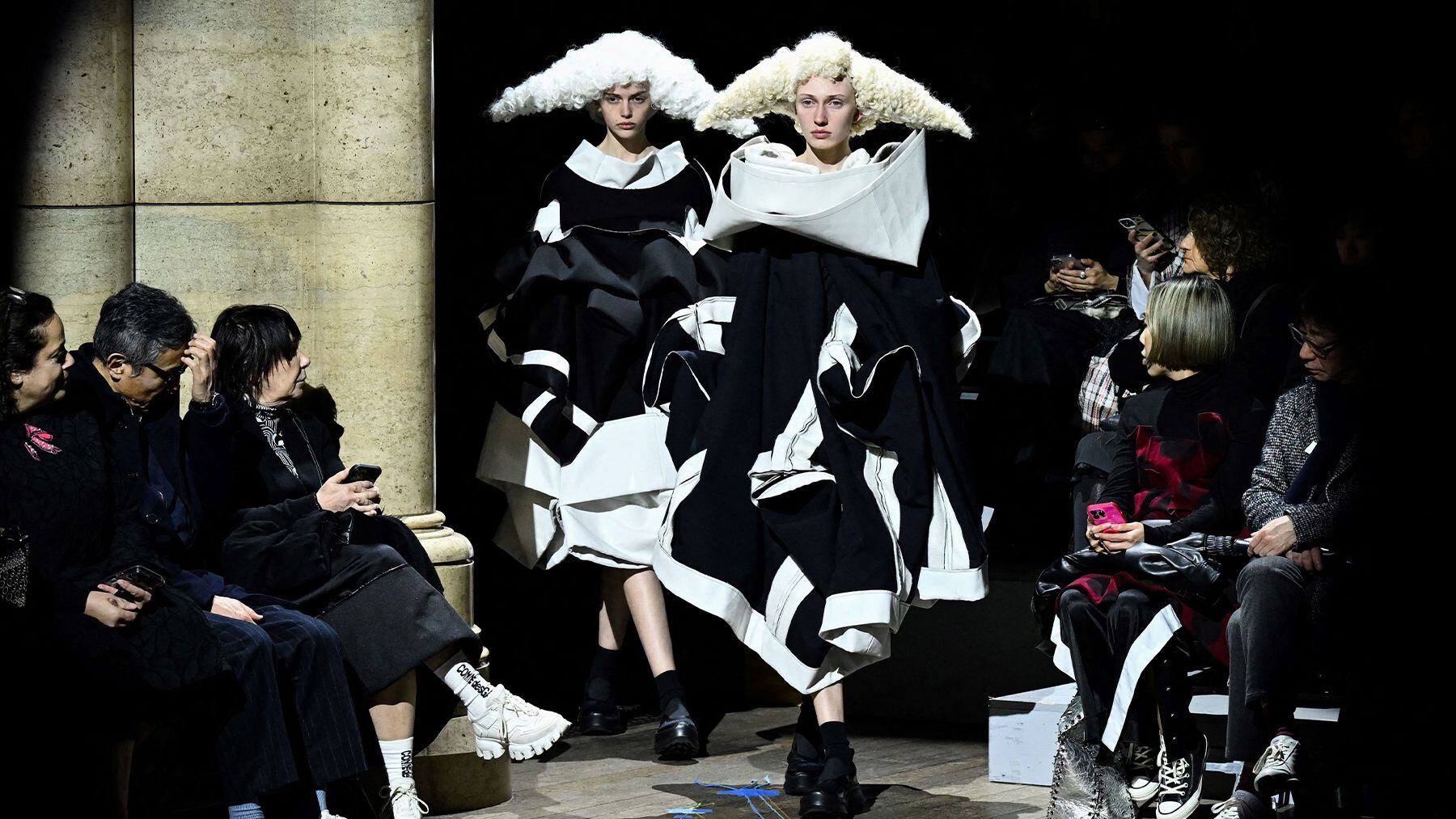Rip It Up And Start Again: Why We Love Comme des Garçons, Junya and Noir
PARIS — Backstage after her shows, Rei Kawakubo usually dispenses a nod, or at most a tentative handshake, to acknowledge a congratulatory comment, but following Saturday’s presentation, she seemed happy to elaborate on the typically gnomic statement that was offered as the show’s manifesto. Which was this: “A feeling of wanting to go back to the starting point.” Everyone assumed that meant Kawakubo was returning to the Ground Zero of Comme des Garçons. The rest of the manifesto certainly suggested as much. “Working with free patterns” and “Using basic materials.” So we all parsed the show for signifiers of CDG collections past. They were there: the 2-D, the bulbous lumps, the surreal frills and furbelows, the blood roses, the hoops and harnesses, the extravagant upending of silhouette… in other words, all the trials that Kawakubo has set herself since Spring/Summer 2014 when she decided she would no longer try to make “clothes.” You might even label this list a greatest bits of CDG Mk.II.
But oh, how wrong you’d be! When Kawakubo talked starting points, she apparently meant nothing less than a restart for the whole human race. I couldn’t agree more. Reflect on the parlous state into which we’ve plunged Planet Earth and the urge to rip it up and start again overwhelms. But imagine a slate that blank in terms of fashion. If that was what Kawakubo was offering, her show was a little disappointing. Basic materials are too familiar for a restart on a planetary scale.
My colleague Cathy Horyn suggested to Kawakubo that her collection was happy. The designer was taken aback. “Not happy,” she muttered. But there was definitely an odd almost-cheeriness in the stop/start bursts of music that accompanied the mini-passages of Kawakubo’s challenges. A prime punk blast of Siouxsie Sioux and the Banshees was followed by jazzy piano, a tinkling spinet, Satie-like piano, big band vibes, Can’s “Vitamin C”, and a closing grungey gust of L7′s “Bad Things”. I get it: all forms of human life were there. But again, that’s familiar. To reset the world, I want coruscating, disorienting strangeness.
Sign in please, Kei Ninomiya of Noir. His manifesto promised us “an exploration of a new dimension”. After his fabulous, flummoxing presentation, his backstage grilling by eager-to-understand journos elicited not much more than the fact he was steadfastly uninfluenced by art, science, nature, any of the things that designers are usually happy to concede as guiding lights in their creativity. That liberated us to free-associate. If new dimensions immediately evoke space, a giant mirrored ball flashing light like a multi-faceted diamond did suggest a visitation from the Great Beyond. On the soundtrack, the Cocteau Twins sounded like they were broadcasting from Alpha Centauri. The radical ceramicist Takuro Kuwata once more contributed headdresses, some of them reminiscent of Asteroid 2011 AG5, which passed over the earth in January.
There were explosions of flowers stitched together — eruptions of mutant life — and undulating metallic arcs, like Frank Gehry’s Bilbao Guggenheim transmogrified into items of clothing. If you were looking for a uniting principle, the idea of networks seemed appropriate. Neural networks in the twisty, intricate nature of the outfits. Or maybe mycelium, whose potential to connect and destroy has been brilliantly, alarmingly illuminated by “The Last of Us.” Makeup artist Amazing Jiro’s facial modifications looked like spreading spores. The scintillating light of the organism that closed the show might have been the phosphorescence of a deep sea creature. Or perhaps it was the O Mind of the Multiverse. It seemed to vibrate in time to the soundtrack, like the music of the spheres.
Remarkably, there were artfully real clothes underpinning Noir’s ultradimensional fantasia. A blanket skirt, a dress over shorts, a boucle officer’s coat, the gothic/noir clothing component of the collection. There is ultimately always a pragmatism to the fabulous avant-garderie of Japan’s fashion talents. Nobody understands this better than Junya Watanabe. It’s been a year since he showed his last collection inspired by motorcycle jackets. That was in a video beamed in from Tokyo. Even though he insists he doesn’t actually like motorbikes, he’s given a lot of love to the look over the years (check out Autumn/Winter 2007 for men and Autumn/Winter 2011 for women). Each time, the take is radically different. On Saturday, he offered biker nomads, inspired by Led Zeppelin’s imperial classic “Kashmir.” Watanabe’s sole comment about the show? “It is an homage to the lyrics and the feeling of desert travel.” (Though Robert Plant actually wrote the lyrics about a long, dusty drive through the south of Morocco. There aren’t any deserts in Kashmir.)
It’s not the first time Watanabe has used Led Zeppelin in a show. It should happen more often. Soundtrackist Michel Gaubert winkled out a distorted snatch of “Whole Lotta Love” before plunging the audience into the symphonic splendour of “Kashmir”, via a live version recorded in 2007. The O2 Arena audience’s ecstatic reaction artfully amplified the reaction of Watanabe’s audience at show’s end.
Before that, six sentinel figures claimed the elevated catwalk like high priestesses in a ritual, faces masked with chains. And then the travelers began their steady march to Led Zepp’s pomp, wrapped, bonded, ringed, tied, zipped and Gore-tex-ed. In a reductive world, people might talk about the high-fashion apotheosis of gorp-core. Here, I was more taken by the notion of Furiosa and her harpies, hellbent on “Fury Road.” There were face masks, at least one lethally spiked and biker jackets deconstructed into panniers or capes for maximum silhouettishness. One jacket was cut away, its tails fanning into a thick fringe. A shearling coat dispersed into godets. It’s that Edwardian tailoring thing that clutches at the heart of Japanese design, and here it was delivered in a perfectly precise symmetry cut from black leather (and pleather, its synthetic analogue). But the presentation — clothes and music combined — made a transcendent statement on the power of women. That felt fundamental.


